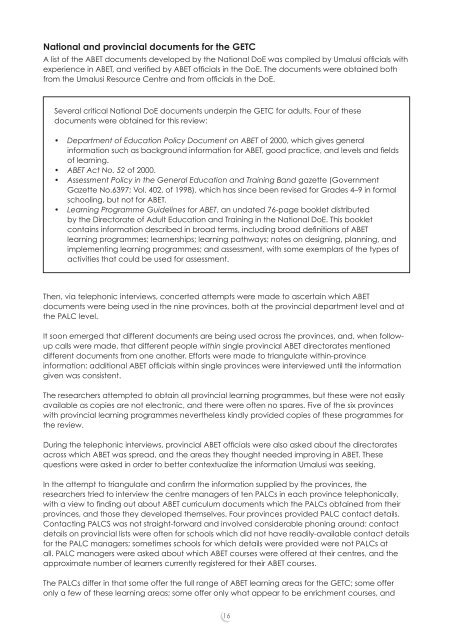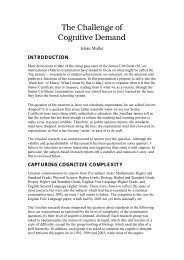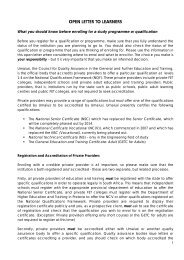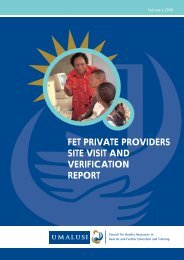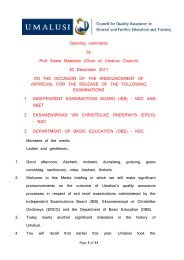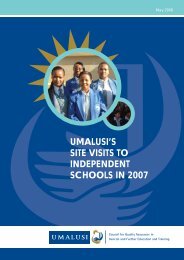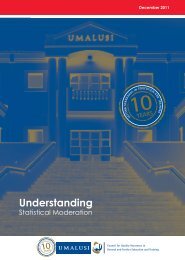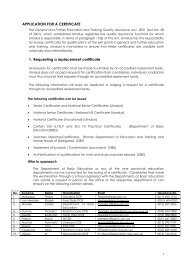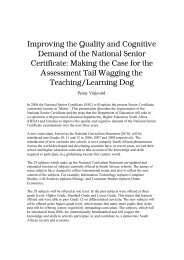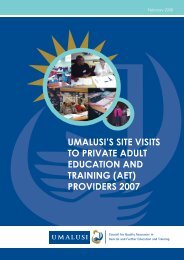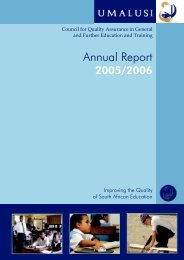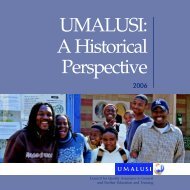Inspecting the Foundations - Umalusi
Inspecting the Foundations - Umalusi
Inspecting the Foundations - Umalusi
Create successful ePaper yourself
Turn your PDF publications into a flip-book with our unique Google optimized e-Paper software.
National and provincial documents for <strong>the</strong> GETCA list of <strong>the</strong> ABET documents developed by <strong>the</strong> National DoE was compiled by <strong>Umalusi</strong> offi cials wi<strong>the</strong>xperience in ABET, and verifi ed by ABET offi cials in <strong>the</strong> DoE. The documents were obtained bothfrom <strong>the</strong> <strong>Umalusi</strong> Resource Centre and from offi cials in <strong>the</strong> DoE.Several critical National DoE documents underpin <strong>the</strong> GETC for adults. Four of <strong>the</strong>sedocuments were obtained for this review:• Department of Education Policy Document on ABET of 2000, which gives generalinformation such as background information for ABET, good practice, and levels and fi eldsof learning.• ABET Act No. 52 of 2000.• Assessment Policy in <strong>the</strong> General Education and Training Band gazette (GovernmentGazette No.6397; Vol. 402, of 1998), which has since been revised for Grades 4–9 in formalschooling, but not for ABET.• Learning Programme Guidelines for ABET, an undated 76-page booklet distributedby <strong>the</strong> Directorate of Adult Education and Training in <strong>the</strong> National DoE. This bookletcontains information described in broad terms, including broad defi nitions of ABETlearning programmes; learnerships; learning pathways; notes on designing, planning, andimplementing learning programmes; and assessment, with some exemplars of <strong>the</strong> types ofactivities that could be used for assessment.Then, via telephonic interviews, concerted attempts were made to ascertain which ABETdocuments were being used in <strong>the</strong> nine provinces, both at <strong>the</strong> provincial department level and at<strong>the</strong> PALC level.It soon emerged that different documents are being used across <strong>the</strong> provinces, and, when followupcalls were made, that different people within single provincial ABET directorates mentioneddifferent documents from one ano<strong>the</strong>r. Efforts were made to triangulate within-provinceinformation: additional ABET offi cials within single provinces were interviewed until <strong>the</strong> informationgiven was consistent.The researchers attempted to obtain all provincial learning programmes, but <strong>the</strong>se were not easilyavailable as copies are not electronic, and <strong>the</strong>re were often no spares. Five of <strong>the</strong> six provinceswith provincial learning programmes never<strong>the</strong>less kindly provided copies of <strong>the</strong>se programmes for<strong>the</strong> review.During <strong>the</strong> telephonic interviews, provincial ABET offi cials were also asked about <strong>the</strong> directoratesacross which ABET was spread, and <strong>the</strong> areas <strong>the</strong>y thought needed improving in ABET. Thesequestions were asked in order to better contextualize <strong>the</strong> information <strong>Umalusi</strong> was seeking.In <strong>the</strong> attempt to triangulate and confi rm <strong>the</strong> information supplied by <strong>the</strong> provinces, <strong>the</strong>researchers tried to interview <strong>the</strong> centre managers of ten PALCs in each province telephonically,with a view to fi nding out about ABET curriculum documents which <strong>the</strong> PALCs obtained from <strong>the</strong>irprovinces, and those <strong>the</strong>y developed <strong>the</strong>mselves. Four provinces provided PALC contact details.Contacting PALCS was not straight-forward and involved considerable phoning around: contactdetails on provincial lists were often for schools which did not have readily-available contact detailsfor <strong>the</strong> PALC managers; sometimes schools for which details were provided were not PALCs atall. PALC managers were asked about which ABET courses were offered at <strong>the</strong>ir centres, and <strong>the</strong>approximate number of learners currently registered for <strong>the</strong>ir ABET courses.The PALCs differ in that some offer <strong>the</strong> full range of ABET learning areas for <strong>the</strong> GETC; some offeronly a few of <strong>the</strong>se learning areas; some offer only what appear to be enrichment courses, and16


